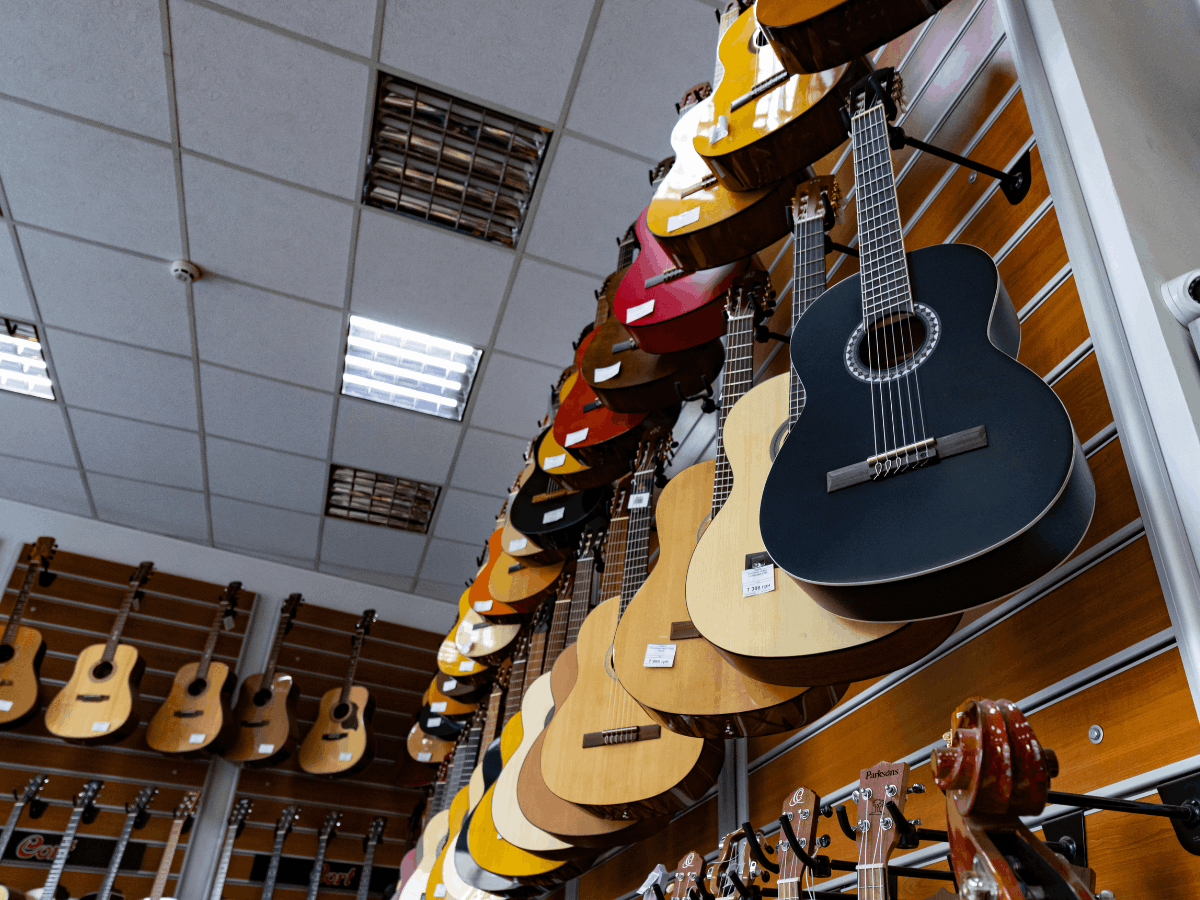Choosing the perfect acoustic guitar can feel like diving into a sea of strings and frets, but it’s easier than you might think. In this blog, we’ll explore how to choose an acoustic guitar for beginners and help you find the right match for your musical journey.
Navigating the world of beginner guitars can be tricky, with options like body shapes and string types. But don’t worry; I’ll guide you step by step to ensure the guitar you pick is not only comfortable to play but also sounds great.
Keep reading as I unfold the secrets to making an informed decision that perfectly suits your needs.
Finding the Right Brand and Model for You
When selecting an acoustic guitar, considering popular brands and models can provide a trustworthy starting point. It’s also worth exploring used guitars and off-brand options for unique finds and potential savings.
Popular Models for Beginners: Yamaha, Fender, and Taylor
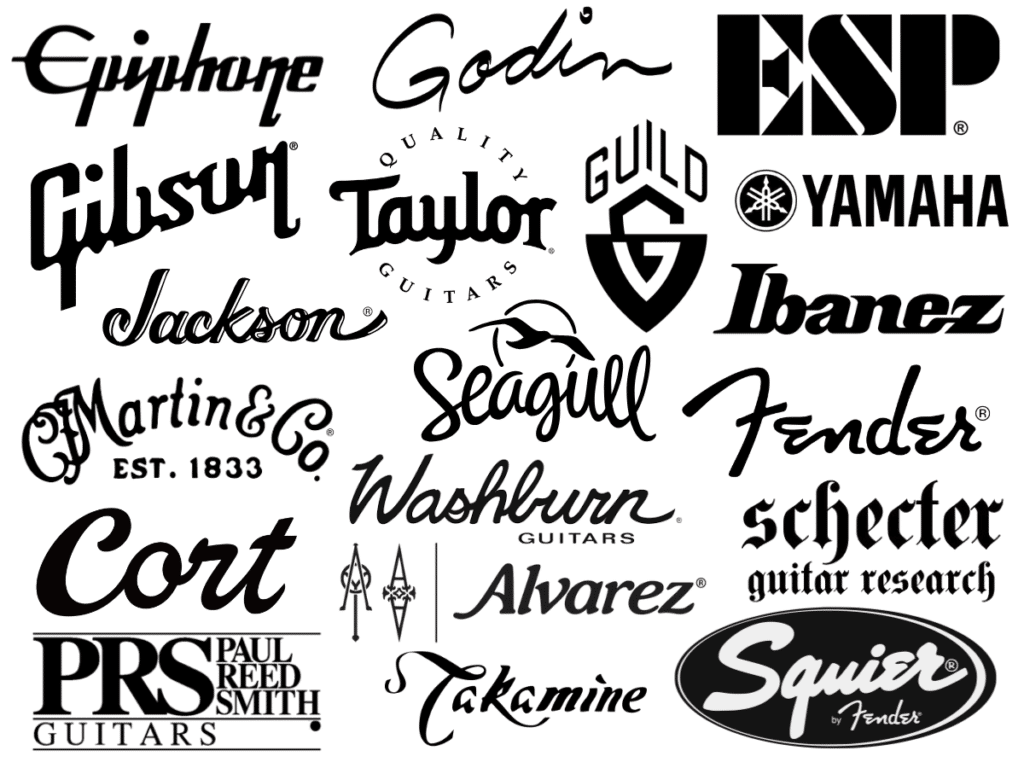
Yamaha consistently delivers quality and affordability, making it a top choice for beginners. My go-to recommendation is the Yamaha FG800, known for its balanced tone and durability.
Fender’s CD-60S is another excellent option, praised for its solid build and easy playability. It’s perfect for those who want a smooth learning experience without breaking the bank.
For players seeking a compact option, the Taylor GS Mini provides a rich, full sound despite its smaller size. This model combines portability with great tone, making it ideal for players on the go.
Exploring Off-Brand Options and Used Guitars
Venturing beyond well-known brands can be rewarding. Epiphone and Gretsch, for instance, offer models like the Gretsch G9500 that blend affordability with style.
Exploring used guitars opens doors to high-quality instruments at reduced prices. Always check for wear and have a trusted friend or expert assist if needed.
The Martin LX1 is a sought-after used guitar, prized for its durability and sound. Buying used allows access to features you might not afford in a new instrument. Never hesitate to explore local shops or online marketplaces for these gems.
Selecting a Guitar Within Your Budget

Choosing an acoustic guitar that fits your budget can be a delightful experience. Finding the right balance between cost and quality ensures you’ll enjoy every strum without breaking the bank.
Affordable Options for Beginners
When I started exploring guitars, I quickly realized that affordable doesn’t mean compromising on sound. Many well-known brands offer beginner models that provide excellent value. Look for models made from laminated wood, which costs less but still delivers decent acoustics. Choosing a guitar from a reputable brand can help ensure quality even at lower price points.
It’s a good idea to visit local music stores or check online marketplaces that often have promotions or sales. Price-match guarantees can further stretch your dollars. Don’t forget to consider secondhand options, either. Many seasoned players upgrade and sell their guitars, offering a chance to get a well-maintained instrument for a fraction of the original price.
Understanding the Price Range of Acoustic Guitars
In my research, I’ve found that acoustic guitars can start as low as $100 and go up into the thousands. For a reliable beginner guitar, expect to spend between $150 and $300. This range typically includes guitars with good construction and sound quality suitable for learning and casual play.
Investing in features that matter most, like a comfortable neck profile and smooth fretboard, can offer a more enjoyable playing experience. Keep an eye out for additional costs that might creep up, like cases, picks, or strap. Being aware of these extras helps me manage my overall budget effectively. This planning ensures that I get the guitar I love without unexpected expenses later on.
Understanding Acoustic Guitar Types
Choosing an acoustic guitar involves knowing the differences between acoustic and electric models, types like dreadnought and OM, and the unique features of nylon string guitars. Each type has specific characteristics that influence sound and playability.
Understanding the Price Range of Acoustic Guitars
When I compare acoustic and electric guitars, I notice distinct differences.
Acoustic Guitar
Electric Guitar
Types of Acoustic Guitars: Dreadnought, OM, and More
Exploring the world of acoustic guitars, I’ve found various body types, each with unique tones and playability.
Dreadnought
OM (Orchestra Model)
The Unique Characteristics of Nylon String Guitars
Nylon string guitars catch my attention with their smooth, mellow tones. They’re commonly used in classical, flamenco, and some folk music genres. The softer strings are gentler on the fingers, making them a smart choice for beginners who may find steel strings too harsh.
I appreciate their distinct neck width, which provides more room for finger placement. This feature allows for precise note playing and intricate fingerstyle techniques. Such guitars emphasize a warm, rounded sound that sets them apart from their steel-string counterparts.
Deconstructing The Anatomy of Acoustic Guitars
Choosing the right acoustic guitar involves understanding key components like body shapes and neck specifications. These factors greatly affect the sound and playability.
Body Shapes and Their Impact on Sound
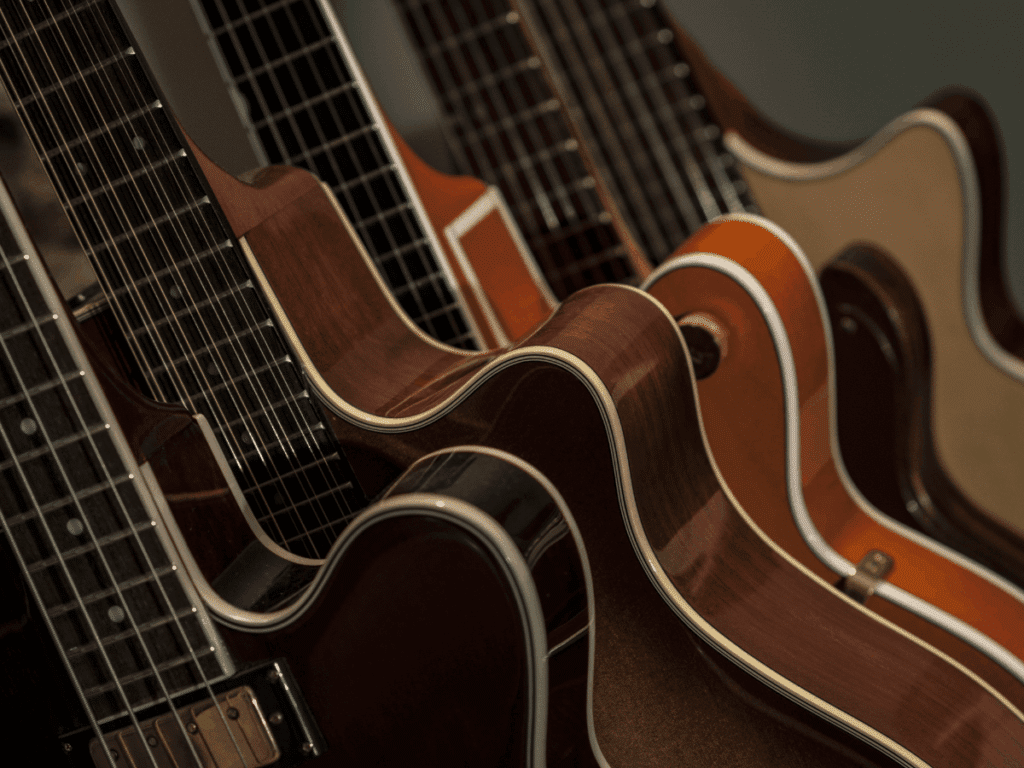
When picking an acoustic guitar, the body shape is crucial. Dreadnoughts are among the most popular, known for their large size and full sound, which is great for strumming and flat-picking. Their squared shoulders and bottom also contribute to a powerful tone.
Parlor guitars, on the other hand, offer a lighter, more articulate sound, ideal for fingerpicking. They have a smaller body, making them comfortable to hold.
Then there’s the jumbo type, offering an even bigger sound, favored for its deep bass resonance. These differences can’t be understated, as they define the guitar’s character and usability in different music genres. Those intrigued by intricate melodies might appreciate the tonal qualities that smaller bodies produce.
Body Shapes and Their Impact on Sound
The neck shape influences comfort and playing style. Some necks are slimmer, ideal for players with smaller hands or those who like speedy chord changes. Others might be chunkier, providing a solid grip for sturdier play.
Acoustic guitars typically join the body at the 12th or 14th fret, influencing how accessible higher notes are.
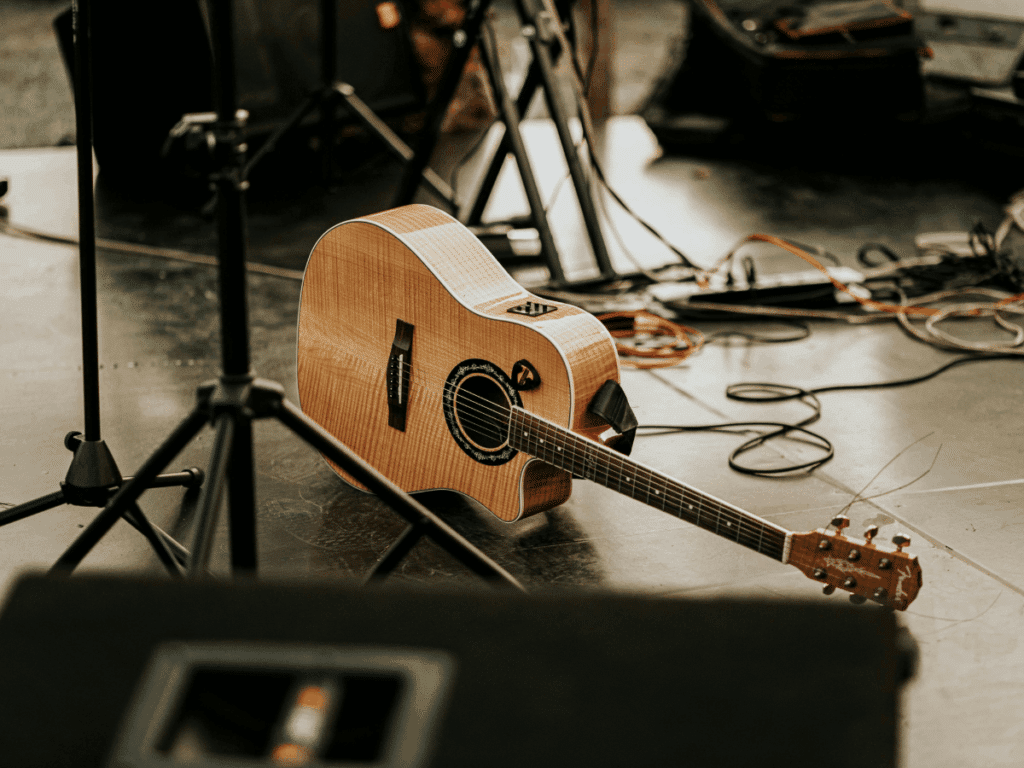
Scale length matters too, affecting string tension and sound. Longer scales offer punchy tone, while shorter ones give a softer, warmer sound. It’s like the difference between a taut rubber band and a slack one. Selecting the right combination can make playing more enjoyable and less physically taxing. The balance between playability and sound is key.
Considering the Right Size for Comfort and Playability
Choosing an acoustic guitar often begins by focusing on the right size, as it plays a key role in comfort and how you play.
How Guitar Size Affects Playing Style

The size of an acoustic guitar can greatly influence how I play and the sound I produce. Larger guitars, like dreadnoughts, offer a rich bass and louder volume. These are often preferred by those who enjoy strumming or playing guitar in larger settings.
In contrast, smaller guitars, like parlors or concert sizes, offer a balanced tone and are easier to manage. They’re ideal for fingerstyle players or when portability matters. I find that the size impacts everything from my reach to the resonance of my performance.
Choosing the Right Guitar for Your Body Size
Finding a guitar that fits my body size ensures comfort and playability. If I have a smaller frame or shorter arms, a ¾ or 7/8 size guitar might be perfect. These sizes are easier to handle, especially for extended sessions.
For those with larger builds, full-sized guitars might offer the best experience, providing more volume and tonal depth. The key is to hold different sizes and notice how my body feels with each. Ensuring a comfortable reach around the neck and proper hand positioning is crucial.
Top 3 Acoustic Guitars We Recommend for Beginners
Martin LX1 Little Martin

PERFECT FOR: Small players. Plus, it’s great for players that need a compact option whether it’s for travel or camping.
COMES WITH: Padded gig bag
FEATURES: Solid Sitka spruce top as well as a modified low oval neck style for ease of use.
- Handmade
- Small size makes it perfect for the young crowd
- Premium solid top emanates clear and intricate sound when strumming.
- Laminated wood body lowers its quality construction
When you click ‘Check Price’, you’ll see there are loads of great places to buy this item. Our personal favorite is Sweetwater for the US, and Thomann and Gear4Music for the UK & Europe.
They are the largest music retailers, with excellent customer service, competitive prices, really fast shipping, and the longest guarantees.
The professional musician who wrote this article combined many things,
from the product build, manufacturer’s reputation through to feedback
from other users, to create our famous TedScore™.
Student Acoustic Guitar by Gear4music + Accessory Pack
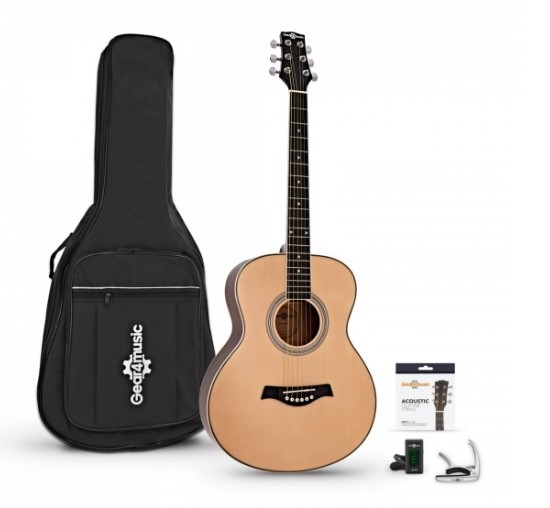
FEATURES: Full-size acoustic guitar
OTHER INFO:Price: £89.99
- Affordable and budget-friendly
- Comprehensive accessory pack included
- Reliable build quality for lasting durability
- Excellent sound projection for its class
- Basic gig bag may offer limited protection.
- Some players may desire a wider tonal range.
When you click ‘Check Price’, you’ll see there are loads of great places to buy this item. Our personal favorite is Sweetwater for the US, and Thomann and Gear4Music for the UK & Europe.
They are the largest music retailers, with excellent customer service, competitive prices, really fast shipping, and the longest guarantees.
The professional musician who wrote this article combined many things,
from the product build, manufacturer’s reputation through to feedback
from other users, to create our famous TedScore™.
Fender CD-60S Acoustic, Natural
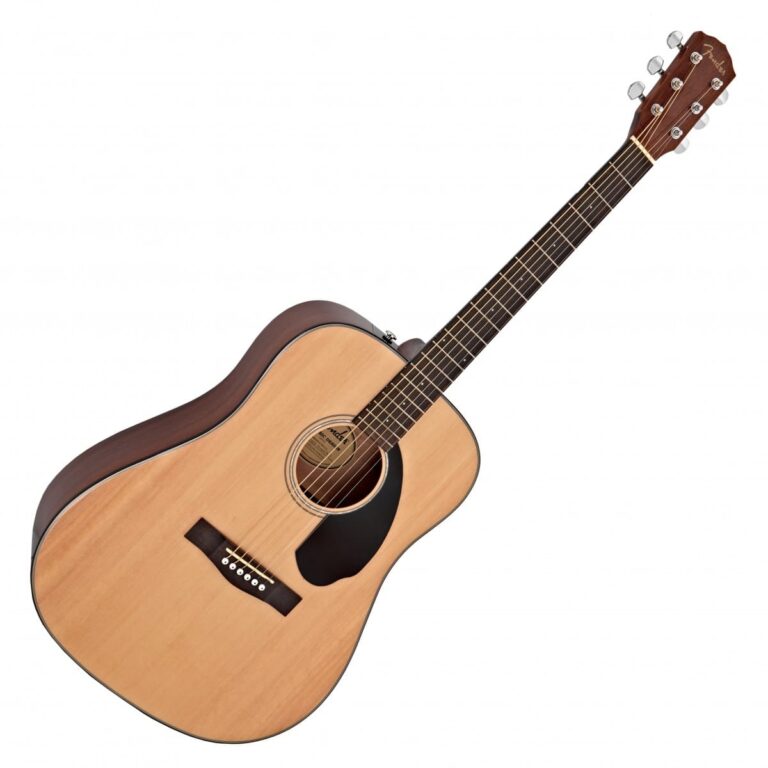
FEATURES: Coated 80/20 Bronze String (.012-.052 Gauge)
OTHER INFO: Number Of Frets: 20
- Walnut fretboard with rolled edges adds a classy detail.
- Exceptionally playable.
- Remarkable value for the price.
- Presents well-balanced tones.
- Out-of-the-box intonation and setup are superb.
- Exhibits a relatively simple appearance.
- Falls short of top-tier craftsmanship.
When you click ‘Check Price’, you’ll see there are loads of great places to buy this item. Our personal favorite is Sweetwater for the US, and Thomann and Gear4Music for the UK & Europe.
They are the largest music retailers, with excellent customer service, competitive prices, really fast shipping, and the longest guarantees.
The professional musician who wrote this article combined many things,
from the product build, manufacturer’s reputation through to feedback
from other users, to create our famous TedScore™.
Evaluating Different Tonewoods
The Influence of Spruce, Mahogany, and Rosewood
When I think about key tonewoods, spruce, mahogany, and rosewood immediately come to mind.
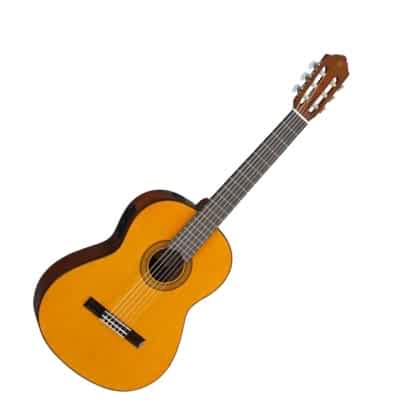
Spruce, particularly solid spruce, is a common top wood due to its bright, clear tone, making it ideal for various styles. It responds well to both strumming and fingerpicking, offering a balanced sound with good projection.

Mahogany is often used for the back and sides of guitars. It provides a warm, mid-range rich tone, which is great for blues and folk music. It adds a certain depth to the sound, offering that sweet spot between brightness and warmth.

Rosewood, on the other hand, brings a full, resonant sound, often described as complex. It’s a favorite for both back and sides in higher-end instruments because it enhances the guitar’s sustain. This wood provides a luxurious sound palette, perfect for creating a rich, smooth tone.
Tonal Differences Between Solid and Laminated Woods
I’ve found that understanding the differences between solid and laminated woods can be crucial. Solid woods, such as solid spruce tops, are known for their superior resonance. They vibrate freely, allowing the guitar to produce a richer, more nuanced tone that often improves with age.
Laminated wood, constructed from multiple layers, offers durability and cost-effectiveness. While it may not enhance the tonal complexity as much as solid wood, it’s more resistant to humidity changes. This makes it a great choice for beginners who want something more affordable and robust, especially when traveling or living in varying climates.
Inspecting Craftsmanship and Build Quality
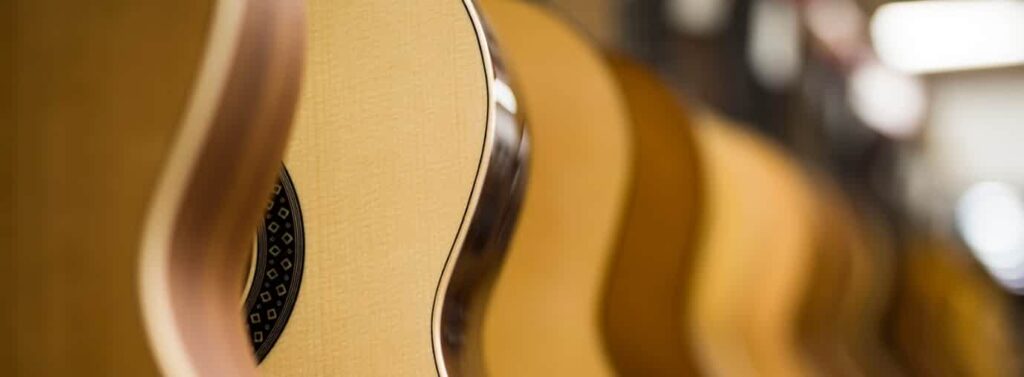
When choosing an acoustic guitar, it’s essential to evaluate the craftsmanship and build quality. By recognizing skilled workmanship and understanding key construction details, you can avoid common pitfalls and ensure your instrument will perform beautifully for years.
Recognizing the Work of a Quality Luthier
A quality luthier knows the importance of precision and attention to detail. I look for smooth fret edges, as these help prevent discomfort while playing. A properly setup guitar neck should be straight without warping. This ensures clear sound without fret buzz. The finish on the guitar surface should be even, revealing the luthier’s commitment to quality. The craftsmanship often reflects in the guitar’s sound and longevity.
The Importance of Good Construction Details
Good construction involves more than just looks. The joinery, such as the connection between the neck and body, must be secure for stable sound production. Well-constructed machine heads facilitate smooth tuning. Materials like quality wood impact sound resonance. A durable bridge secures the strings and adds tonal stability. Precise fret placement ensures good intonation across the fretboard.
Signs of Poor Construction to Avoid
Poor construction can lead to issues like uneven fretwork, which might cause fret buzz. Warped necks can result in unmanageable playability. A rough or unfinished surface may hint at rushed work. Loose or poorly attached hardware can impact tuning stability. Inconsistent grain or poorly matched wood pieces might suggest shortcuts that affect sound quality. These signs should raise red flags and influence my buying decision.
Deciding Between Acoustic and Acoustic-Electric Guitars
As I explore options for beginners, I find myself weighing the features of acoustic and acoustic-electric guitars. The choice depends on your playing needs and how you envision your musical journey unfolding.

Pros and Cons of Acoustic-Electric Hybrids
Acoustic-electric guitars offer the flexibility of playing unplugged or amplified, making them quite versatile. I think about how useful this is for performances where amplification is necessary. The built-in electronics often include EQ controls and tuning options, which are handy for quick adjustments on stage.
However, it’s worth noting that these guitars might require additional maintenance. Battery replacements and checking electronic components become part of their upkeep. This might not suit beginner players who prefer simplicity. The additional cost of acoustic-electrics could also be a factor, especially when budget considerations come into play.
In contrast, pure acoustic guitars focus on rich, natural sound without the need for electronics. They’re typically less complex, which some beginners might find appealing.
The Importance of Sound: Tone and Resonance

When I think about the best acoustic guitars, tone and resonance jump to the forefront. These two elements dictate the sound and character of a guitar. The type of wood, or tonewood, used in crafting a guitar significantly impacts its sound.
Different woods offer unique tonal qualities. Mahogany, for instance, often gives a warm tone. It’s great if I’m looking for something mellow and rich. On the other hand, spruce is known for providing a bright sound. It projects well and resonates crisply.
Let’s talk about the soundboard, the top of the guitar. This area is crucial because it vibrates to amplify the sound when strummed. The choice of wood here changes the overall resonance and tonal balance.
The back and sides also play their part. While the soundboard handles most of the resonance, the back and sides can shape sound projection and influence volume. Mixing and matching different woods can lead to vibrant or subtle sounds.
Selecting the right guitar involves understanding how these elements interact. Whether I’m playing blues, rock, or classical, I focus on tone and resonance. Do I want something resonant and lively? Then I look for combinations that suit my musical style.
In conclusion, understanding how tone and resonance work helps me choose a guitar that’s in sync with my sound preference.
Learning Basic Maintenance and Care

When it comes to maintaining an acoustic guitar, fundamental care practices are key to preserving its quality and sound. Simple routines like cleaning and addressing environmental conditions can make a significant difference in the longevity and performance of the guitar.
Simple Cleaning and String Changing Procedures
Keeping an acoustic guitar clean is crucial for maintaining its sound and appearance. I wipe down my guitar with a soft, lint-free cloth after each use to remove fingerprints and dust. Regular cleaning prevents grime buildup that can affect tone quality.
Changing strings is another essential task. Strings should be replaced every few months or when they start sounding dull. To change strings, I loosen the old strings, remove them, and then thread new strings through. I ensure they are properly tightened and tuned.
Simple Cleaning and String Changing Procedures
Humidity and temperature fluctuations can harm an acoustic guitar. Maintaining the right humidity level, ideally between 45-55%, prevents the wood from drying or warping. I use a guitar humidifier for stable conditions.
Temperature fluctuations should also be minimized. I never leave my guitar in a car or near heat sources. By storing it in a sturdy case, I protect it from excessive environmental changes.
Both humidity control and temperature regulation are essential for a guitar’s sound and structure. These simple yet effective practices ensure that my acoustic guitar remains in excellent condition for years to come.
Getting Started with Playing Techniques
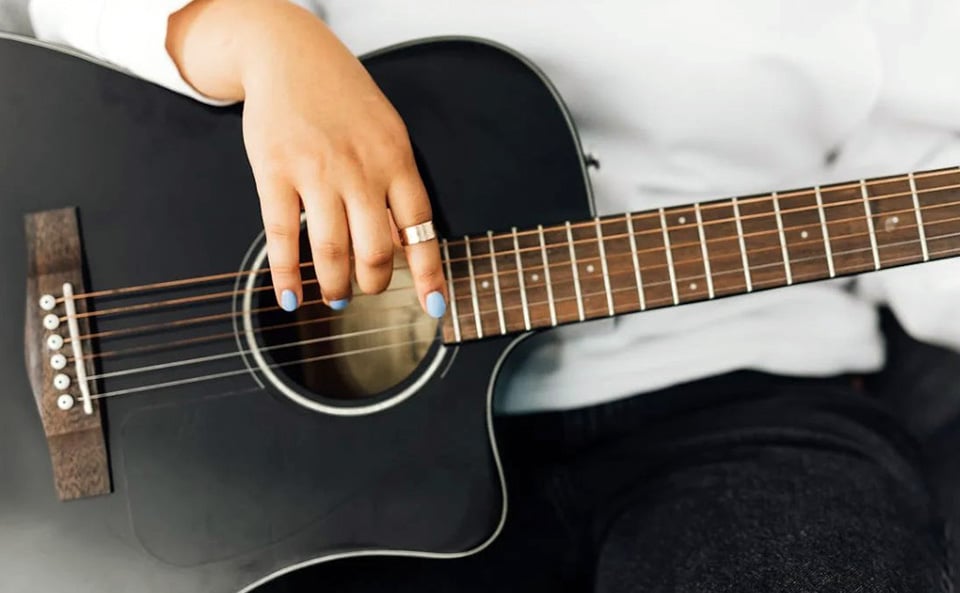
When I begin playing acoustic guitar, focusing on key techniques like strumming and fingerpicking is essential. These skills form the backbone of my playing style and allow me to express a wide range of musical ideas.
Strumming Patterns and Techniques for Beginners
Starting with basic strumming, I position my hand comfortably over the strings. The wrist should be relaxed, allowing for smooth, flowing movements.
I begin with simple patterns like downstrokes on each beat. This helps me establish a rhythm. As I progress, I introduce upstrokes to create more dynamic patterns.
I often practice these patterns slowly, using a metronome. Listening to songs I enjoy and trying to mimic their strumming styles is beneficial. It’s also fun.
Sometimes, muting the strings with the palm of my strumming hand can add a percussive quality.
The Basics of Fingerpicking
Fingerpicking offers a beautiful, melodic way to play. I start by assigning my thumb to the bass strings. The index, middle, and ring fingers each take a set of treble strings.
Practicing simple patterns with steady tempo helps develop coordination. I might start with a basic p-i-m-a pattern. This spans thumb, index, middle, and ring.
This technique allows me to highlight individual notes within chords. I emphasize practicing slowly, focusing on clarity and timing.
As I gain confidence, I experiment with different timing and patterns. This creates varied textures and enhances my playing style.
How To Choose Acoustic Guitar
For Beginners
Summary
When embarking on the journey to find the perfect acoustic guitar, several factors come into play. I make sure to consider the guitar’s playability and sound quality. These elements form the core of a rewarding musical experience.
Budget is another key consideration. There are fantastic options out there for every price range, so I focus on what’s comfortably affordable while ensuring I get value for my money. The Yamaha FG800 and Fender CD-60S are examples that combine quality with affordability.
Another aspect is durability. I want my guitar to withstand regular use, and exploring various brands helps me identify those renowned for their sturdiness. Engaging with brands like Seagull and Alvarez often provides models that meet this need.
Lastly, aesthetics and additional features can enhance the playing experience. While these aren’t always a priority for beginners, having a guitar that looks and feels right can often boost the motivation to practice. Exploring options with unique finishes or built-in electronics can be exciting features.
Each of these factors plays a role in finding a guitar that not only suits my needs as a beginner but also supports my future growth as a musician.


